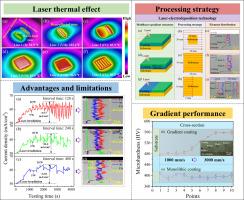Exploring the application of laser thermal effect in the multilayer gradient coatings designed by electrochemical deposition: Parameters, advancements, and limitations
IF 6.1
1区 工程技术
Q1 ENGINEERING, MANUFACTURING
引用次数: 0
Abstract
This study presents an innovative approach distinct from conventional electrochemical deposition (ECD) techniques to produce multilayer gradient Fe-Ni coatings. This process incorporates the effective integration of laser energy fields, and the detailed thermal impact was extensively analyzed. The correlation between laser effects on the ECD process, element content, and microstructure was verified from the perspective of thermal effects. Even without altering the original face-centered cubic structure, the introduction of lasers significantly affects the distribution of element content and grain size. Therefore, this study presents two new laser-ECD processes that enable the fabrication of multilayer gradient structures. One approach involves obtaining a multilayer structure with alternating element content along the cross-section, from bottom to top. This is achieved by periodically varying current densities generated by continuously alternating thermal gradients formed through laser scanning. The second method aims to create a gradient structure prepared by adjusting the laser parameters that vary laterally or longitudinally along the substrate. Furthermore, the effectiveness of the gradient performance was demonstrated by revealing microstructure evolution and testing the microhardness. Finally, the advantages and limitations of laser thermal effects in preparing multilayer gradient structures are summarized.

探索激光热效应在电化学沉积法设计的多层梯度涂层中的应用:参数、进步和局限性
本研究提出了一种有别于传统电化学沉积(ECD)技术的创新方法,用于生产多层梯度铁-镍涂层。该工艺结合了激光能量场的有效整合,并对详细的热影响进行了广泛分析。从热效应的角度验证了激光对 ECD 过程、元素含量和微观结构影响之间的相关性。即使不改变原始的面心立方结构,激光的引入也会显著影响元素含量和晶粒大小的分布。因此,本研究提出了两种能制造多层梯度结构的激光-ECD 新工艺。一种方法是沿横截面从下至上获得元素含量交替变化的多层结构。这是通过激光扫描形成的连续交变热梯度产生的周期性变化电流密度来实现的。第二种方法的目的是通过调整沿基底横向或纵向变化的激光参数来制作梯度结构。此外,通过揭示微观结构演变和测试显微硬度,证明了梯度性能的有效性。最后,总结了激光热效应在制备多层梯度结构中的优势和局限性。
本文章由计算机程序翻译,如有差异,请以英文原文为准。
求助全文
约1分钟内获得全文
求助全文
来源期刊

Journal of Manufacturing Processes
ENGINEERING, MANUFACTURING-
CiteScore
10.20
自引率
11.30%
发文量
833
审稿时长
50 days
期刊介绍:
The aim of the Journal of Manufacturing Processes (JMP) is to exchange current and future directions of manufacturing processes research, development and implementation, and to publish archival scholarly literature with a view to advancing state-of-the-art manufacturing processes and encouraging innovation for developing new and efficient processes. The journal will also publish from other research communities for rapid communication of innovative new concepts. Special-topic issues on emerging technologies and invited papers will also be published.
 求助内容:
求助内容: 应助结果提醒方式:
应助结果提醒方式:


